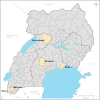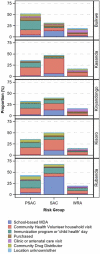Prevalence and intensity of soil-transmitted helminth infections in Uganda: Results from population-based prevalence surveys in five districts
- PMID: 37751418
- PMCID: PMC10522024
- DOI: 10.1371/journal.pntd.0011605
Prevalence and intensity of soil-transmitted helminth infections in Uganda: Results from population-based prevalence surveys in five districts
Erratum in
-
Correction: Prevalence and intensity of soil-transmitted helminth infections in Uganda: Results from population-based prevalence surveys in five districts.PLoS Negl Trop Dis. 2023 Dec 6;17(12):e0011804. doi: 10.1371/journal.pntd.0011804. eCollection 2023 Dec. PLoS Negl Trop Dis. 2023. PMID: 38055731 Free PMC article.
Abstract
Background: Soil-transmitted helminth (STH) infections are caused by roundworms (Ascaris lumbricoides), whipworms (Trichuris trichiura), and hookworms (Necator americanus and Ancylostoma duodenale). In Uganda, baseline surveys conducted during the late 1990s and early 2000s suggested STH infections were common, with prevalence >50% among surveyed schoolchildren. In 2003, a national program was launched with mass preventative chemotherapy (PC) and health education for children 1-14 years old. Little evidence is available to show the impact of national deworming.
Methods: We conducted population-based, cross-sectional household surveys in five districts (Buikwe, Kassanda, Kiryandongo, Kisoro, and Rubanda) in March and May 2022. Our primary objective was to estimate STH prevalence by species due to infections of any intensity and infections of moderate-to-heavy intensity among preschool-aged children (PSAC, 1-4 years old), school-aged children (SAC, 5-14 years old), and women of reproductive age (WRA, 15-49 years old). Laboratory technicians used duplicate Kato-Katz microscopy to determine fecal egg count.
Results: Overall, 3,352 PSAC; 3,884 SAC; and 1,226 WRA provided stool samples. The prevalence of any infection remained high in Kisoro at or above ~50% within all risk groups. In other districts, the prevalence of any infection ranged from approximately 5 to 16% among PSAC, 6 to 23% among SAC, and 12 to 19% among WRA. Moderate-to-heavy intensity infection prevalence was highest in Kisoro (~15-26%), followed by Rubanda (<5%), and was ≤1% in other districts. A. lumbricoides and T. trichiura infections were largely confined to Kisoro and Rubanda, whereas hookworm was most common in other districts.
Conclusions: The STH prevalence has decreased markedly in three districts in Uganda. Based on our findings, the national deworming program should consider decreasing PC distribution frequency in these districts per the World Health Organization guidelines. Efforts are needed to understand why the Kisoro and Rubanda districts did not demonstrate similar gains.
Copyright: © 2023 Tinkitina et al. This is an open access article distributed under the terms of the Creative Commons Attribution License, which permits unrestricted use, distribution, and reproduction in any medium, provided the original author and source are credited.
Conflict of interest statement
The authors have declared that no competing interests exist.
Figures




References
-
- World Health Organization. Soil-transmitted helminth infections. In: Soil-transmitted helminth infections [Internet]. 18 Jan 2023. [cited 17 Jan 2023]. Available: https://www.who.int/news-room/fact-sheets/detail/soil-transmitted-helmin...
-
- Ending the neglect to attain the Sustainable Development Goals–A road map for neglected tropical diseases 2021–2030. Geneva: World Health Organization; 2020. Available: https://creativecommons.org/licenses/by-nc-sa/3.0/igo
-
- Vaz Nery S, Pickering AJ, Abate E, Asmare A, Barrett L, Benjamin-Chung J, et al. The role of water, sanitation and hygiene interventions in reducing soil-transmitted helminths: interpreting the evidence and identifying next steps. Parasit Vectors. 2019;12: 273. doi: 10.1186/s13071-019-3532-6 - DOI - PMC - PubMed
Publication types
MeSH terms
LinkOut - more resources
Full Text Sources

